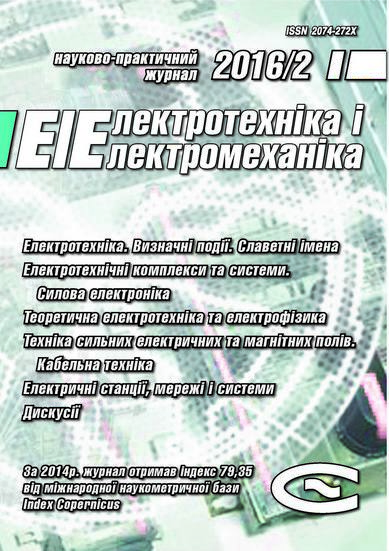COMPONENTS OF TOTAL ELECTRIC ENERGY LOSSES POWER IN PQR SPATIAL COORDINATES
DOI:
https://doi.org/10.20998/2074-272X.2016.2.02Keywords:
energy supply system, p-q-r power theory, the minimum possible losses, total losses power, Matlab-model of the three-phase energy supply systemAbstract
Purpose. To obtain relations determining the components of the total losses power with p-q-r power theory for three-phase four-wire energy supply systems, uniquely linking four components: the lowest possible losses power, losses power caused by the reactive power, losses power caused by the instantaneous active power pulsations, losses power caused by current flowing in the neutral wire. Methodology. We have applied concepts of p-q-r power theory, the theory of electrical circuits and mathematical simulation in Matlab package. Results. We have obtained the exact relation, which allows to calculate the total losses power in the three-phase four-wire energy supply system using three components corresponding to the projections of the generalized vectors of voltage and current along the pqr axis coordinates. Originality. For the first time, we have established a mathematical relationship between spatial representation of instantaneous values of the vector components and the total losses power in the three-phase four-wire energy supply systems. Practical value. We have elucidated an issue that using the proposed methodology would create a measuring device for determining the current value of the components of total losses power in three-phase systems. The device operates with measuring information about instantaneous values of currents and voltages.References
1. Akagi H., Kanazawa Y., Nabae A. Generalized theory of the instantaneous power in three phase circuits. Int. Power Electronics Conf., Tokyo, Japan, 1983, pp. 1375-1386.
2. Akagi H., Kanazawa Y., Nabae A. Instantaneous reactive power compensators comprising switching devices without energy storage components. IEEE Transactions on Industry Applications, 1984, vol.IA-20, no.3, pp. 625-630. doi: 10.1109/TIA.1984.4504460.
3. Nabae A., Tanaka T. A new definition of instantaneous active-reactive current and power based on instantaneous space vectors on polar coordinates in three-phase circuits. IEEE Transactions on Power Delivery, 1996, vol.11, no.3, pp. 1238-1243. doi: 10.1109/61.517477.
4. Czarnecki L.S. What is wrong with the Budeanu concept of reactive and distortion power and why it should be abandoned. IEEE Transactions on Instrumentation and Measurement, 1987, vol.IM-36, no.3, pp. 834-837. doi: 10.1109/TIM.1987.6312797.
5. Czarnecki L.S. Misinterpretations of some power properties of electric circuits. IEEE Transactions on Power Delivery, 1994, vol.9, no.4, pp. 1760-1769. doi: 10.1109/61.329509.
6. Ghassemi F. Should the theory of power be reviewed? L’energia electrica, 2004, vol.81, pp. 85-90.
7. Peng F.Z., Ott G.W., Adams D.J. Harmonic and reactive power compensation based on the generalized instantaneous reactive power theory for three-phase four-wire systems. IEEE Transactions on Power Electronics, 1998, vol.13, nо.6, pp. 1174-1181. doi: 10.1109/63.728344.
8. Afonso J., Couto C., Martins J. Active filters with control based on p-q theory. IEEE Industrial Electronics Society Newsletter, 2000, vol.47, no.3, pp. 5-10.
9. Soares V., Verdelho P., Marques G.D. An instantaneous active and reactive current component method for active filters. IEEE Transactions on Power Electronics, 2000, vol.15, no.4, pp. 660-669. doi: 10.1109/63.849036.
10. Kim H.S., Akagi H. The instantaneous power theory on the rotating p-q-r reference frames. Proceedings of the IEEE 1999 International Conference on Power Electronics and Drive Systems. PEDS'99 (Cat. No.99TH8475), 1999, pp. 422-427. doi: 10.1109/PEDS.1999.794600.
11. Shidlovskii A.K. Tranzistornye preobrazovateli s uluchshennoi elektromagnitnoi sovmestimost'iu [Transistor converters with improved electromagnetic compatibility]. Kiev, Naukova Dumka Publ., 1993. 272 p. (Rus).
12. Mykhal's'kyy V.M. Zasoby pidvyshchennya yakosti elektroenerhiyi na vkhodi i vykhodi peretvoryuvachiv chastot iz shyrotno-impul'snoyu modulyatsiyeyu [Means improve power quality input to output frequency converters with pulse-width modulation]. Kiev, Instytut elektrodynamiky NAN Ukrayiny Publ., 2013. 340 p. (Ukr).
13. Zhemerov G.G., Tugay D.V. Physical meaning of the «reactive power» concept applied to three-phase energy supply systems with non-linear load. Elektrotekhnіka і elektromekhanіka – Electrical engineering & electromechanics, 2015, no.6, pp. 36-42. (Rus). doi: 10.20998/2074-272X.2015.6.06.
14. Zhemerov G.G., Tugay D.V. An universal formula clarification to determine the power losses in the three-phase energy supply systems. Visnyk NTU «KhPІ» – Bulletin of NTU «KhPІ», 2015, no.12, pp. 339-343. (Rus).
15. Artemenko M.Yu., Batrak L.M., Mykhalskyi V.M., Polishchuk S.Y. Analysis of possibility to increase the efficiency of three-phase four-wire power system by means of shunt active filter. Tekhnichna elektrodynamika – Technical electrodynamics, 2015, no.6, pp. 12-18. (Ukr).
Downloads
Published
How to Cite
Issue
Section
License
Copyright (c) 2016 George G. Zhemerov, D. V. Tugay

This work is licensed under a Creative Commons Attribution-NonCommercial 4.0 International License.
Authors who publish with this journal agree to the following terms:
1. Authors retain copyright and grant the journal right of first publication with the work simultaneously licensed under a Creative Commons Attribution License that allows others to share the work with an acknowledgement of the work's authorship and initial publication in this journal.
2. Authors are able to enter into separate, additional contractual arrangements for the non-exclusive distribution of the journal's published version of the work (e.g., post it to an institutional repository or publish it in a book), with an acknowledgement of its initial publication in this journal.
3. Authors are permitted and encouraged to post their work online (e.g., in institutional repositories or on their website) prior to and during the submission process, as it can lead to productive exchanges, as well as earlier and greater citation of published work.




